Devarol-S-200000 IU ampoule Solution in for I.M. injection & Oral route Cholecalciferol (Vit. D3) 1. NAME OF THE MEDICINAL PRODUCT Devarol-S-200000 IU/2ml ampoule 2. QUALITATIVE AND QUANTITATIVE COMPOSITION Each 2ml contains: Active Ingredients: Cholecalciferol (Vit. D3) 5 mg (equivalent to 200000 I.U.) For the list complete excipients, see section 6.1. 3. PHARMACEUTICAL FORM Pale yellow clear solution free from visible particles in an ampoule for I.M. injection & Oral route. 4. CLINICAL DATA 4.1. Therapeutic indications Prophylaxis and/ or treatment of deficiency in vitamin D. 4.2. Dosage and method of administration 1 ampoule contains 200,000 IU of vitamin D3. Mode of administration : IM route. The ampoule can also be administered orally. Prevention of vitamin D deficiency It is generally accepted that prophylaxis of vitamin D deficiency should be: • systematic: o in newborns and infants, o in pregnant women (last trimester) and breastfeeding women at the end of winter and spring, o in the elderly, o possibly in children and adolescents if they are not sufficiently exposed to the sun. • under the following conditions: o no sun exposure or strong skin pigmentation with: unbalanced diet (poor in calcium, vegetarian, etc.) or extensive dermatological pathology, or granulomatous disease (tuberculosis, leprosy, etc.) o subjects taking anticonvulsants (barbiturates, phenytoin, primidone), o subjects receiving long-term corticosteroid therapy, o digestive diseases (intestinal malabsorption and cystic fibrosis), o hepatic insufficiency. The dosages are as follows: In infants(more than 3 months) receiving milk enriched with vitamin D: 1/2 ampoule (i.e. 100,000 IU) every 6 months. In breastfed infants (more than 3 months )or those not receiving milk enriched with Vitamin D and in young children up to 5 years old: 1 ampoule (i.e. 200,000 IU) every 6 months. In adolescents: 1 ampoule (i.e. 200,000 IU) every 6 months during winter. In pregnant women: 1/2 ampoule (i.e. 100,000 IU) in the 6th or 7th month of pregnancy, possibly repeated once after a month, when the last trimester of pregnancy begins in winter or in case of non-exposure to the sun. In the elderly: 1/2 ampoule (i.e. 100,000 IU) every 3 months. In children or adults with digestive diseases: 1/2 to 1 ampoule (i.e. 100,000 to 200,000 IU) every 3 months. In children or adults taking anticonvulsant treatment: 1/2 to 1 ampoule (i.e. 100,000 to 200,000 IU) every 3 months. In children or adults in other special conditions other than those described above: 1 ampoule (i.e. 200,000 IU) every 6 months. Treatment of vitamin D deficiency (rickets, osteomalacia, neonatal hypocalcemia): 1 ampoule (i.e. 200,000 IU) possibly repeated once after 1 to 6 months. 4.3. Contraindications • Hypersensitivity to the active substance or to any of the excipients mentioned in section 6.1. • Hypercalcemia, hypercalciuria, calcium lithiasis. 4.4. Special warnings and precautions for use • To avoid any overdose, take into account the total doses of vitamin D when combining several treatments containing this vitamin. • Monitor calciuria and serum calcium and stop vitamin D intake if serum calcium exceeds 105 mg/ml (2.62 mmol/l) or if Urinary calcium exceeds 4 mg/kg/day in adults or 4-6 mg /kg/day in children. • In case of high calcium intake, regular monitoring of calciuria is essential. This medicine contains 125 mg propylene glycol in each 2ml ampoule (62.5mg/1ml). 4.5. Interactions with other drugs and other forms of interactions Associations subject to precautions for use + Enzyme-inducing anticonvulsants: Decrease in vitamin D concentrations is more marked than in the absence of inducer. Modify the dosage of different concentrations of vitamin D and its supplementation if necessary. + Rifampicin: Decrease in vitamin D concentrations is more marked than in the absence of treatment with rifampicin. Modify the dosage of different concentrations of vitamin D and its supplementation if necessary. Associations to be taken into account + Orlistat: Decreased absorption of vitamin D. Other interactions: *Metronidazole: Discontinue consumption of alcohol or products containing propylene glycol during and for at least three days after therapy with metronidazole. Use of oral metronidazole is associated with a disulfiram-like reaction to alcohol, including abdominal cramps, nausea, vomiting, headaches, and flushing. 4.6. Fertility, pregnancy and breastfeeding There are no teratogenesis studies available in animals. Clinically, significant follow-up seems to rule out a malformative or fetotoxic effect of vitamin D. Therefore, vitamin D can be prescribed during pregnancy if necessary. If needed, vitamin D can be prescribed during breastfeeding. 4.7. Effects on the ability to drive and use machines Not applicable.
